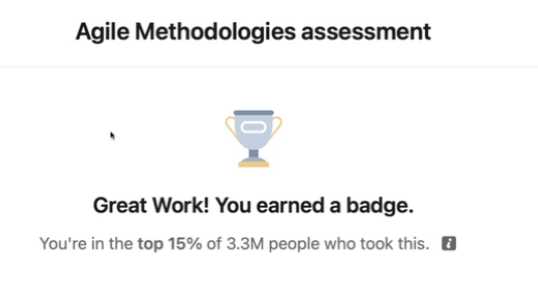Passing the LinkedIn Assessment Test for Agile Methodologies
 laurent brusa
laurent brusa
Today I took the LinkedIn assessment test for Agile, and I'm happy to share that I successfully passed. Out of the 3.3 million individuals who participated, I ranked in the top 15%.
Preparation for the assessment took a significant portion of my time in the last week. With only two attempts at my disposal, I approached the test with a mix of anticipation and uncertainty. Many questions felt ambiguous and by some of them, I am still not entirely sure which answers are wrong.
Many questions felt ambiguous and by some of them, I am still not entirely sure which answers are wrong. It did help that I kept in my mind the Agile values which I learned. Especially remembering that the teams in Agile are self-organising!
The questions I had and how I answered.
Here are the questions I had. I added some remarks by some of them to explain my answer. Feel free to disagree in the comments!
And keep in mind that some of them might be the wrong answer so please don't take this as a cheat sheet! ☺️.
Q1 The team has an incomplete story at the end of the sprint and wants to claim partial credit for the work completed. What should you do?
Explain that, in Agile, working software is the primary measure of progress. Then help the team identify the lesson to be learned from the experience.
Ask the Product Owner to revise the acceptance criteria so it can be accepted and counted.
Ask the Product Owner to accept the story with the promise that the team will complete it in the next sprint.
Ask them to slice the story to reflect the work done and the work to be done.
My answer: 2
Remarks: A promise won't do. Story slicing is a possibility, but the team would not get points. The manifesto even states: "Working software is the primary measure of progress". So it should be number 1? But it is too patronising perhaps?
So I chose number 2 but in hindsight, it doesn't feel right.
Q2 The Product Owner is focused on testing a new system concept in the marketplace as quickly and inexpensively as possible. What is this first-generation product called?
minimum viable product
preproduction version
focus group demonstrator
Generation 1 product
My answer: 1
Remarks: This was a no-brainer.
Q3 What is a Lean Canvas?
It is a template for lightweight business plans that makes your assumptions explicit.
It is a technique for projecting growth in market share.
It is used to decompose the solution into epics, features, and stories.
It is a tool to plan future product releases.
My answer: 1
Remarks: Of course 1
Q4 When is the best time to review the team's burndown chart?
before the Sprint Retrospective
before quarterly planning
before the Daily Scrum
after the daily stand-up
My answer: 3
Remarks: I believe the team's burndown chart should be updated every day before the Daily Scrum. Here it says: "Reviewing". So it might have been a trick question. Who knows 🤷🏻♂️.
Q5 Where are teams most likely to find the first signs of potential problems?
Daily Scrums
Sprint Demos
Sprint Planning
Retrospectives
My answer: 3
Remarks: This was a no-brainer. The first signs can only be in the first sprint planning of course.
Q6 What should happen if the Product Owner does hot accept a story by the end of the iteration?
The team does not get credit for the story's points in its velocity calculation.
The story should be sliced to reflect the work completed.
The acceptance criteria should be adjusted to reflect the work completed.
The story should be shown to stakeholders for their feedback.
My answer: 1
Remarks: Here I realize that I contradicted myself in regard to Q1. So one of these answers might be wrong! However, the formulation is here slightly different and the first answer is correct.
Q7 You are facilitating a meeting to decompose user stories and, unexpectedly, a development team member cannot attend. What should you do?
Ask all meeting participants what they want to do about the one person's absence.
Reschedule the meeting for when all necessary people can attend.
Hold the meeting and update the person who could not attend later.
Ask the person who could not attend to reschedule the meeting based on their availability.
My answer: 1
Remarks: Here I reminded myself that the team in Agile is self-organizing, so it should be up to the team to decide.
Q8 What is not a technique used for splitting user stories?
split by line-of-business
split by alternative paths
split compound user stories
split by interface
My answer: 3
Remarks: The "compound user stories" is not a technique, it is what we start with, so it feels out of place compared to the others.
Q9 Which statement is not true about pair programming?
It is a great way to teach someone who is new to the team.
In pair programming, two developers share one computer and take turns at the keyboard.
The code produced by two developers who are collaborating is typically higher quality than if they were working alone.
It has been discredited because it is too expensive.
My answer: 4
Remarks: Easy.
Q10 What is the term for a team member who is "T-shaped"?
apprentice developer
generalizing specialist
cross-functional
jack-of-all-trades
My answer: 2
Remarks: I was divided between "generalizing specialist" and "cross-functional", but number two is more precise and I found it in Agile books so I went for it.
Q11 Progress toward a sprint goal is in jeopardy because you have not received sales data. What should you do?
Work around the issue until the last responsible moment to solve it.
Check the Product Owner's schedule and book time for a meeting.
Share the problem with your team to see if they can create a solution.
Be sure to mention the issue in the next Scrum.
My answer: 3
Remarks: Here again, I reminded myself that the team in Agile is self-organizing, so it should be up to the team to decide. Other options take too long.
Q12 The team is not going to complete its Sprint Commitment. As the Team Facilitator, what should you do?
Report this at the Sprint Review.
Advise the PO as soon as possible.
Point out the reasons why and collaborate on solutions.
Ask the PO to extend the sprint.
My answer: 2
Remarks: It feels like a job description for a Team Facilitator. Facilitate and collaborate. Sprints cannot be extended btw.
Q13 Which statement about the actor in a user story can be true?
There must be multiple personas for each actor.
The actor does not have to be a specified role in the solution.
The actor can be the system itself.
The system cannot be the actor.
My answer: 3
Remarks: I believe here they try to confuse me. 😀
Personas and actors are not the same.
The actor is not a persona. Actors can be a person, group, or system(s).
Q14 The Scaled Agile Framework advocates that, if you measure only one thing, what should you measure?
cost of delay
predictability of delivery
quality
return on investment
My answer: 1
Remarks: Tricky. They seem to be all quite important but I had the feeling by reading a lot of Agile blogs that the cost of delay gets mentioned quite often so I went for it.
Q15 What is the definition of capacity?
It is the maximum number of stories that will be allowed in a sprint.
It is an inventory of the team's knowledge and skills that is used to plan the work that they do.
It is the number of teams that a Team Facilitator can support concurrently.
It means the team determines their availability for the next sprint.
My answer: 1
Remarks: Easy.
Some resources:
Subscribe to my newsletter
Read articles from laurent brusa directly inside your inbox. Subscribe to the newsletter, and don't miss out.
Written by

laurent brusa
laurent brusa
Hi there 👋 My name is Laurent and I am an iOS Developer based in Berlin.👨🏻💻 Please have a look at my portfolio. And at my CV! My area of interest include: • Programming in Swift. • UIKit with both storyboards and programmatic UI. • Develop cross-platform native apps with SwiftUI. 📫 You can also DM me on Mastodon or Bluesky!